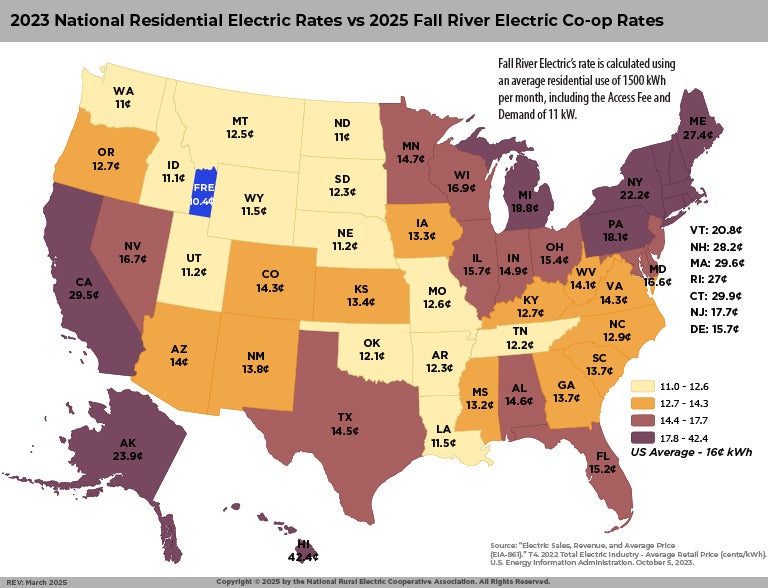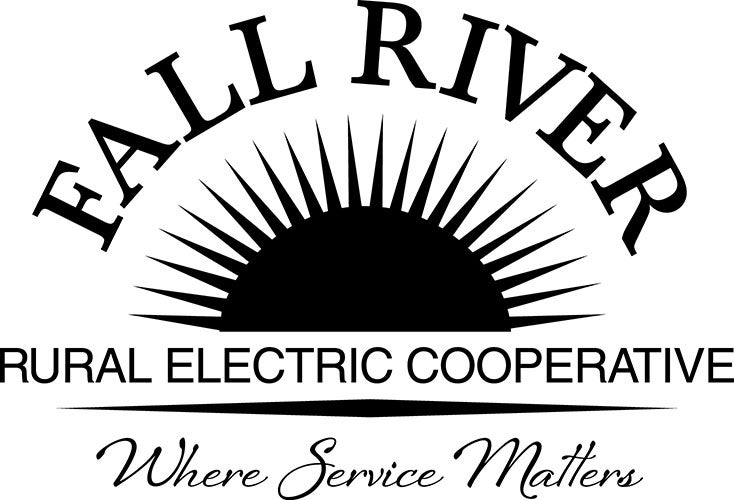The demand for electricity both locally and nationally is causing wholesale rates to increase significantly which has resulted in Fall River Electric Cooperative having to implement a rate increase effective with bills members receive in May 2025. This rate change reflects an average increase of just 3.9%, although depending on usage, individual accounts may see more or less of an increase. The average Fall River Electric residential bill is about $123.00/month and will see an increase of about $6.00 per month.
Members in each rate classification can now use these calculators to make a comparison of their monthly costs before and after the rate change.
Residential Rate Comparison Calculator
Small General Service Rate Comparison Calculator
Large General Service Comparison Calculator
Irrigation Comparison Calculator
Your bill is composed of an Access Fee charge of $39 for residential service accounts and small general service accounts and $59 for larger general service accounts, all of which remain the same each month. The other two parts are the demand and a kilowatt hour charge, both which can change depending on the amount of energy you use.
For large new service loads of 2MW or greater, please refer to General Policies #304 which states the Co-op's CEO/General Manager will develop, implement, and administer a cost-based retail rate for any proposed new service of this size. The rate will be fair, equitable, and non-subsidizing to existing members.
Rates are set by the elected owner-members of the Fall River Board of Directors.
Access Fee
This charge ensures all members pay their fair share of fixed costs. Without it, year-round members would pay the majority of fixed costs for seasonal residents, who make up about 40 percent of the Cooperative’s membership. Even if you use no electricity for an entire season, the Cooperative must maintain the physical facilities, billing, accounting, and the payment of loans, insurance, and other member services.
*If a member disconnects from Residential or General Service, switching to Idle Service rate, and reconnects within 12 months of the disconnect date, the Access Fee charge for the respective rate class will be applied for that time period, less any Idle Service charges billed for.
Demand (kW) Charge
This is for the amount of peak demand usage measured in kilowatts "kW" (not kilowatt hours) within a billing month. Demand is determined by the highest number of kilowatts you use in a 15-minute period and is another tool members have available for them to control and potentially reduce their monthly bill. Higher demand results in increased power and infrastructure costs. The Demand charge helps align member billing with the Cooperative's costs for demand. Click this link: www.fallriverelectric.com/demand-resources to learn ways to better control the amount of demand you use monthly.
Kilowatt hour (kWh) Charge
This charge pays for the energy you consume. Fall River purchases about 85% percent of the power that is delivered to members from wholesale sources. Most of this power is purchased through the Bonneville Power Administration, which sells power from large federal hydropower projects in the Northwest.
The remaining 15 percent of power that is delivered to members comes from power generated at the Cooperative’s hydroelectric projects on the Henry’s Fork Watershed. Two of these power projects comprise our Green Power program.
Click the link to Open Rate Summary Effective for May 2025 Statements


